In 2025, the demand for responsive, interactive, and high-performance web applications continues to grow. Frontend JavaScript frameworks play an important role in meeting these demands. They give developers the tools to build dynamic, scalable, and efficient web apps.
These frameworks streamline development, offering pre-built solutions that save time, enhance user experience, and improve performance. They are now an essential part of modern web development. They help make complex tasks easier and improve workflow.
JavaScript frameworks have improved a lot since the early days of web development. At that time, developers created websites using only HTML, CSS, and plain JavaScript. Today, frameworks like React, Angular, and Vue.js provide many features. These features help manage the increasing complexity of modern web apps.
In this blog, we will explore the 10 best frontend JavaScript frameworks for developers in 2025. We will look at the key features, benefits, and possible drawbacks. This will help you make a smart choice based on your project’s needs.
Continue reading if you want to choose the most popular frontend JavaScript frameworks loved by developers in 2025 for your next web development project!
What Are The Best Frontend JavaScript Frameworks In 2025?
React is clearly the finest frontend JavaScript framework of the last several years, according to Statista. Besides React, other popular frameworks like Angular and Vue.js remain strong. They have good community support, flexibility, and strong performance.
Nevertheless, frameworks are gradually gaining traction. The requirement for lightweight, high-performance, and scalable solutions is propelling innovation in the field. Developers now have a wide range of options to choose from. Each option has its own set of benefits based on project requirements.
Here is a list of the best frameworks for frontend development. These frameworks are shaping frontend development in 2025.
Table of Contents
1. React
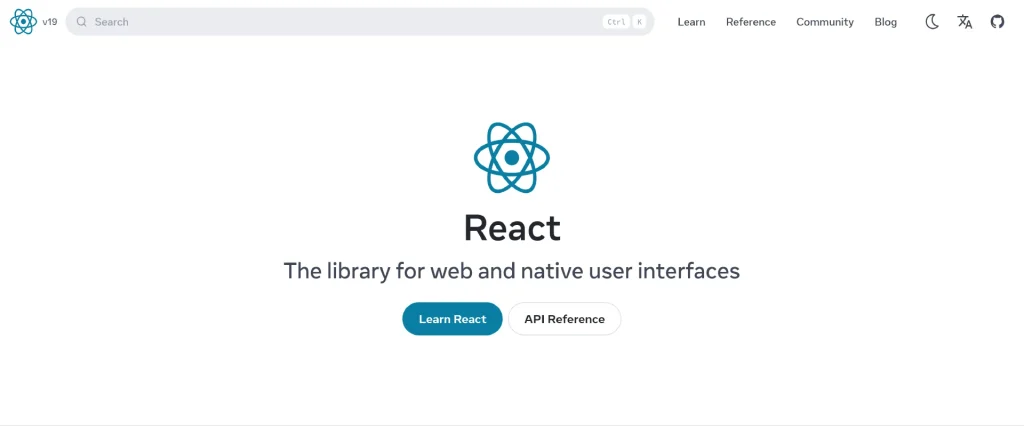
React.js remains one of the most popular JavaScript frameworks in 2025 because of its performance, adaptability, and large community. It is actually one of the JavaScript libraries; however, many people commonly refer to it as a frontend JavaScript framework.
Facebook first created React in 2011 and open-sourced it in 2013, revolutionizing web development. The following are some of the features that make it an industry standard:
- Its component-based architecture allows React developers to build reusable UI components, improving maintainability and scalability.
- The virtual DOM (Document Object Model) improves performance. It updates only the parts of the UI that have changed. This means it does not reload the whole web page.
- Ensures a unidirectional data flow, making applications more predictable and easier to debug.
- Advanced features that simplify state management and optimize performance.
- Unlike traditional frontend frameworks for web development, React.js has improved SEO capabilities with server-side rendering (SSR).
| Pros | Cons |
|---|---|
| You can reuse components across projects, which reduces development time. | Its syntax can be challenging for beginners unfamiliar with JavaScript extensions. |
| Extensive resources, libraries, and third-party tools make problem-solving easier. | Large applications may require additional libraries like Redux or Context API for efficient data handling. |
| The virtual DOM and efficient state management ensure smooth user experiences. |
Industry leaders like Netflix, Airbnb, and Tesla widely use React. React is still one of the top frontend JavaScript frameworks for building modern apps in 2025. This is because of ongoing improvements, a strong community, and support from Meta (Facebook).
2. Angular
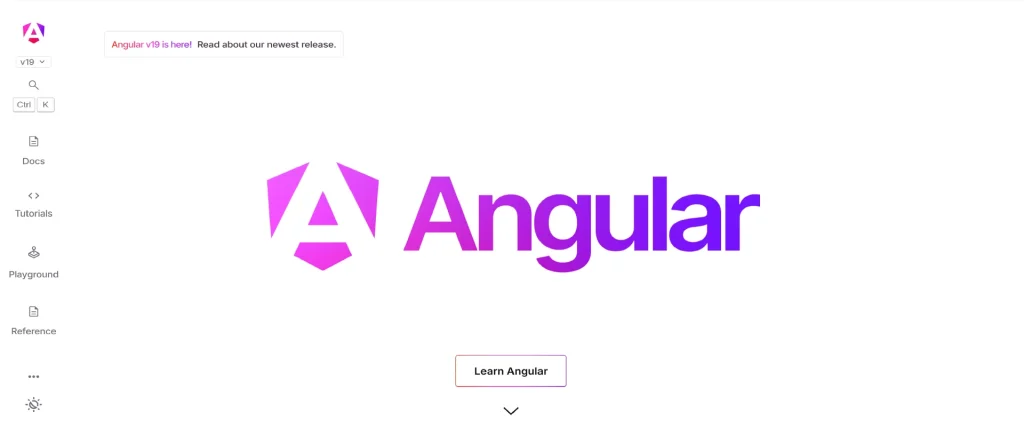
Angular, developed by Google, was launched as AngularJS in 2010. The developers completely rewrote it in 2016 as Angular 2+, adopting a component-based architecture similar to React. Angular.js is a TypeScript-based frontend JavaScript framework designed for building scalable and progressive web applications.
Key features of Angular.js are:
- Two-way data binding ensures automatic synchronization between the model and the view.
- Enhances the modularity and reusability of components.
- Use a change detection method with an Ahead-of-Time (AOT) compiler. This converts templates into optimized JavaScript before running. This process improves performance.
- Built-in routing & form handling provide essential features without relying on third-party libraries.
- Strong TypeScript integration offers Angular developers better tooling and code maintainability.
| Pros | Cons |
|---|---|
| Suitable for large-scale applications with complex architectures. | Requires understanding of TypeScript, RxJS, and Angular’s unique concepts. |
| Google’s Long-Term Support ensures consistent updates and security patches. | Compared to lightweight alternatives like React or Vue, Angular’s size can impact performance. |
| Its broad ecosystem includes Angular CLI, RxJS, and built-in development tools. |
Angular is a popular JavaScript framework in 2025. It is great for enterprise applications, Progressive Web Apps (PWAs), and complex multi-page apps. Major companies like Google, Microsoft, IBM, and Forbes use Angular due to its reliability and scalability.
With regular updates and strong community support, Angular is a reliable framework for large web development in 2025.
3. Vue.js
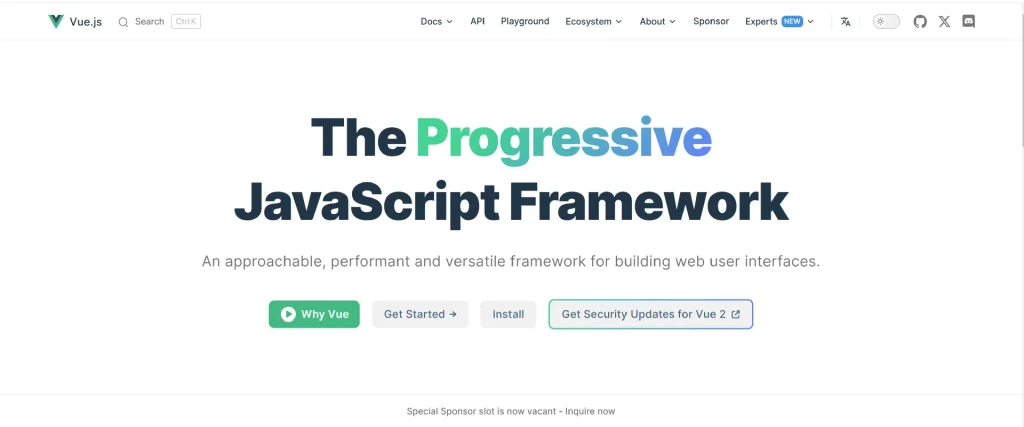
Vue.js is one of the most lightweight and flexible frontend JavaScript frameworks in 2025, making it a top choice for developers. Evan You created Vue.js in 2014. It combines the best features of Angular and React. At the same time, it keeps things simple and easy to use.
Further, it allows Vue.js developers to gradually integrate features, making it ideal for both small and large projects.
The salient features of Vue.js are:
- Component-based architecture encourages reusability and maintainability.
- Two-way data binding ensures seamless synchronization between the UI and application state.
- Virtual DOM enhances performance by updating only necessary parts of the UI.
- The Composition API (Vue 3) provides better reactivity, scalability, and project organization.
- You can use it in existing projects without a complete rewrite.
| Pros | Cons |
|---|---|
| Vue is an extremely quick and scalable tool because of its small size and simplicity. | Fewer resources and third-party libraries compared to React and Angular. |
| Simple syntax and detailed documentation make it easy to learn. | Fewer enterprise-level adoptions mean fewer job opportunities. |
| Suitable for SPAs, PWAs, and mobile applications. | It requires careful planning for large-scale applications to avoid performance issues. |
| Its rich ecosystem includes Vue Router for routing and Vuex for state management. |
Despite its relatively lower market share, Alibaba, Xiaomi, GitLab, and 9GAG trust Vue for their web applications. Its popularity is steadily growing, especially among startups and developers who appreciate its simplicity and efficiency.
4. Ember.js
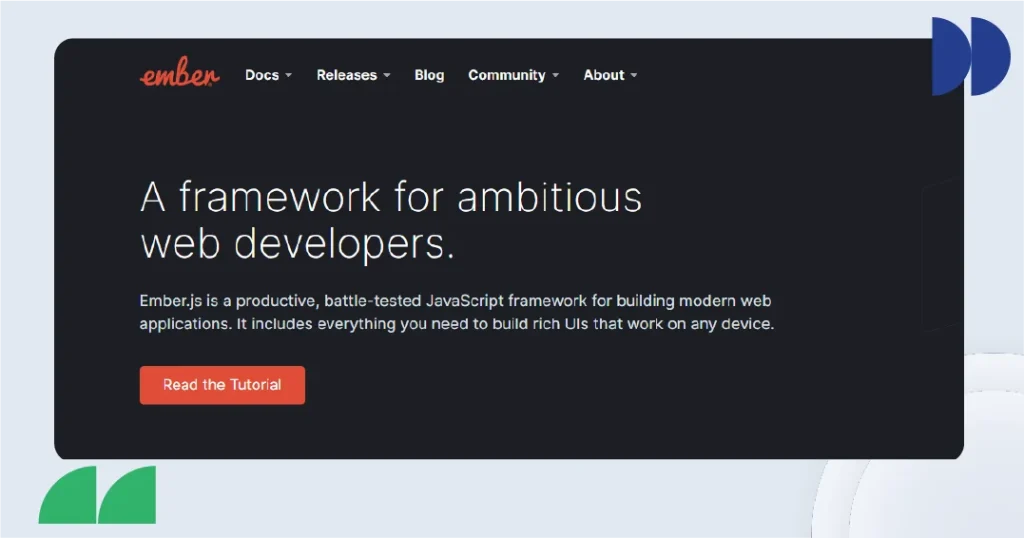
Ember.js is a powerful and opinionated frontend JavaScript framework designed for building large-scale, ambitious web applications. Yehuda Katz created it in 2011 and based it on the Model-View-ViewModel (MVVM) architecture. It has integrated solutions for data retrieval, state management, and routing.
Ember.js has the following key features:
- Two-way data binding makes sure that templates and components update automatically.
- Component-based design encourages the use of reusable user interface elements.
- Ember CLI is a reliable command-line tool for managing dependencies and creating code.
- Convention over Configuration: It enforces best practices and cuts down on setup time.
- Robust URL management that facilitates incremental data fetching and nested routes.
| Pros | Cons |
|---|---|
| Fast development with built-in tools and generators. | Steep learning curve compared to React or Vue. |
| Stable and scalable, ideal for enterprise applications. | Not ideal for small projects due to its complexity. |
| Well-documented, with rich tutorials and guides. |
Ember is ideal for large-scale projects that need long-term support, scalability, and stability. LinkedIn, Microsoft, Netflix, and Twitch commonly employ it, showcasing its reliability in enterprise environments.
5. Svelte
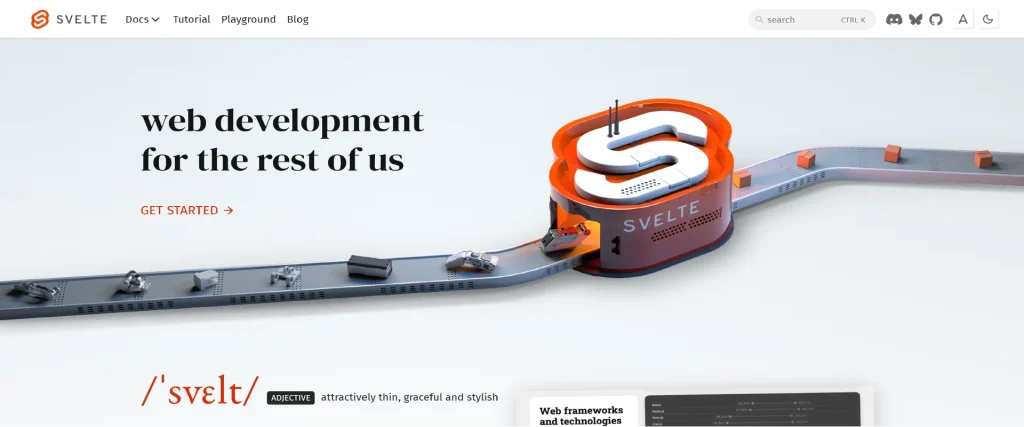
Rich Harris founded Svelte in 2016, making it a relatively recent addition to the frontend landscape. Svelte is a compiler-based JavaScript framework that transforms declarative components into optimized vanilla JavaScript at build time. Unlike React or Vue, it does not use a virtual DOM, leading to faster performance and reduced bundle sizes.
Svelte features include:
- Converts components into optimized JavaScript during build time.
- Directly updates the real DOM for better performance.
- Built-in reactivity without additional state management libraries.
| Pros | Cons |
|---|---|
| Smaller bundle sizes and improved runtime performance. | Fewer resources and third-party libraries compared to React or Vue. |
| Simple syntax using HTML, CSS, and JavaScript. | Lacks extensive development tools for debugging and testing. |
| Built-in state management eliminates the need for external state management libraries. | Scalability is still unproven for enterprise-level applications. |
Svelte is gaining traction, especially with the introduction of SvelteKit, which enhances its capabilities for full-stack applications. Svelte is perfect for media-rich websites that need to be highly responsive, small to medium-sized apps, and single-page apps (SPAs).
React, Vue, Svelte, or something else? A quick chat with our team could save you months of development time and avoid costly rewrites later.
6. Backbone.js
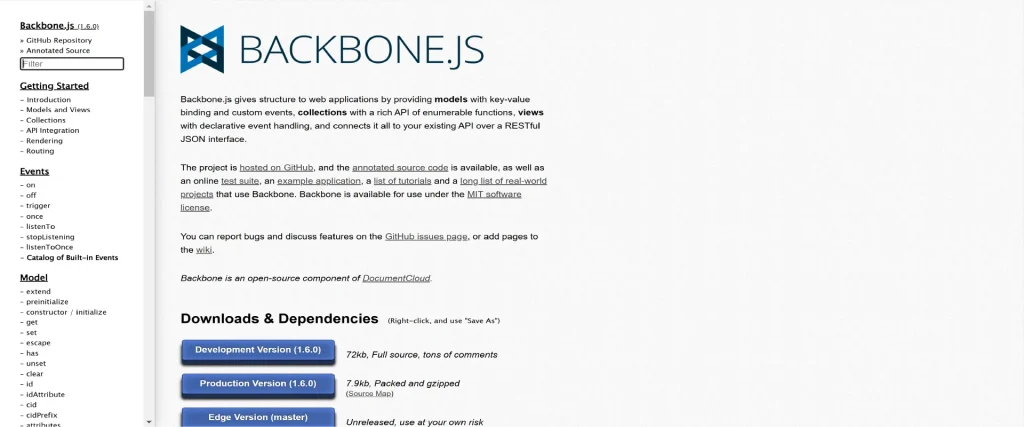
Backbone.js is a lightweight frontend JavaScript framework designed for building structured single-page applications (SPAs). Jeremy Ashkenas created Backbone.js in 2010.
The major features of Backbone.js are:
- Backbone.js application uses the Model-View-Presenter (MVP) architecture. This setup divides the data (model), user interface (view), and event handling (presenter).
- The modest size of the core library makes it perfect for online applications that prioritize speed.
- Backbone.js easily combines with RESTful APIs that use JSON, making client-server data synchronization easier.
| Pros | Cons |
|---|---|
| Backbone.js provides only the essential components, allowing developers to customize their stack with preferred libraries. | Backbone relies on Underscore.js and jQuery, increasing setup complexity. |
| Helps developers maintain clean, modular, and scalable applications by enforcing a structured approach. | Unlike frameworks like Angular, changes in the UI don’t automatically update the model. |
| With over a decade of development, Backbone has numerous plugins and extensions to enhance functionality. | Developers need a solid understanding of JavaScript and RESTful APIs to use Backbone effectively. |
Backbone.js remains a solid choice for lightweight applications that require structure without excessive overhead. Major companies like Walmart, Airbnb, and SoundCloud still use it.
7. jQuery
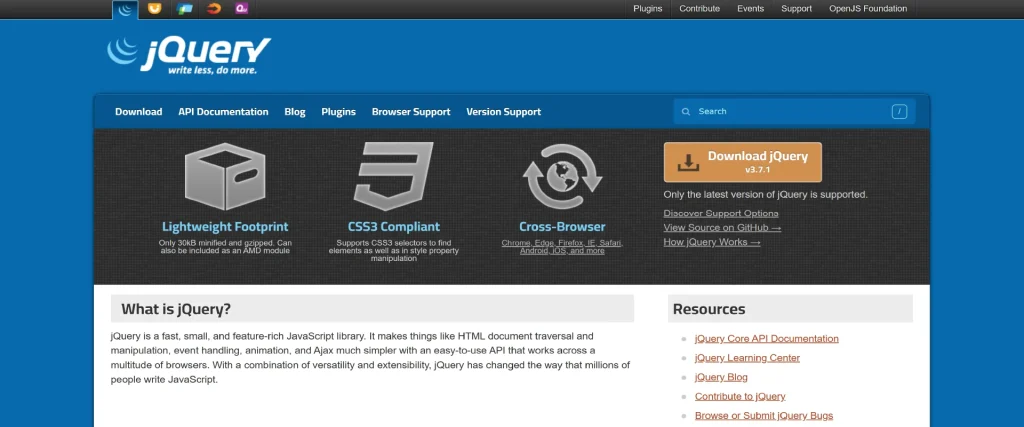
jQuery, introduced in 2006 by John Resig, is an older frontend development framework. Similar to React, jQuery is technically a library. However, many frontend software engineers treat it as a framework because it somewhat meets the definition of one.
The main features of jQuery are:
- DOM manipulation makes it simple to choose and change HTML elements.
- Offers a simple API for managing user communications.
- Adding interactive animations with little coding is possible using Animations & Effects.
| Pros | Cons |
|---|---|
| Easy to learn and use, making it great for beginners. | Compared to modern JavaScript frameworks, jQuery can be inefficient. |
| Works seamlessly across all major browsers. | Native JavaScript methods have replaced many features. |
| A vast ecosystem with extensive documentation and plugins. | Not ideal for large apps because it lacks the structure and efficiency needed for complex applications. |
jQuery is still valuable for legacy projects and small-scale applications. However, its performance limitations and outdated APIs make it less suitable for modern and large-scale SPAs.
Even with the growth of modern developer-friendly JavaScript frameworks, big companies like Google, Microsoft, and IBM still use jQuery. This shows that jQuery is still important in web development.
8. Semantic-UI
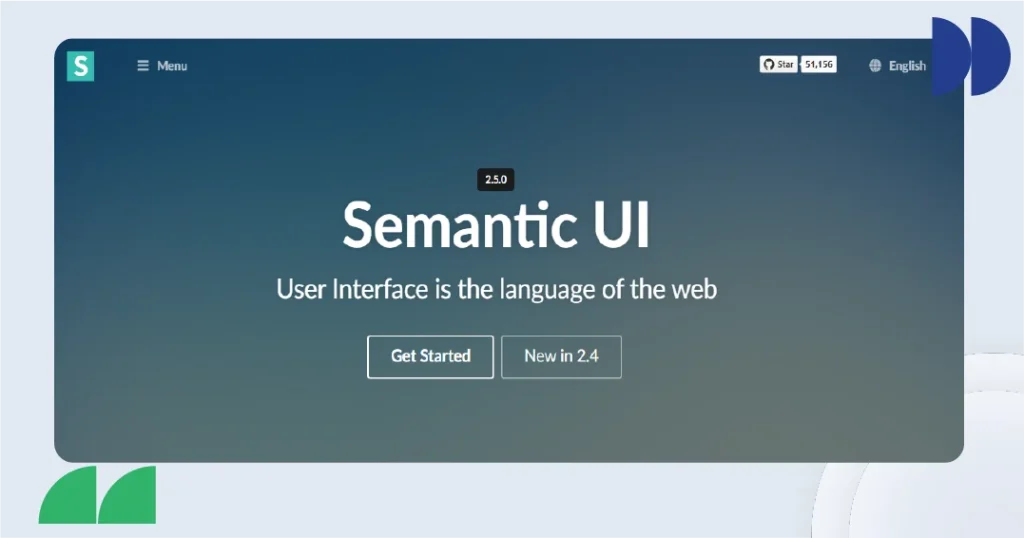
Semantic-UI is a frontend JavaScript framework. It improves web development by using clear HTML. This makes it easy to understand and learn. Launched in 2013, it offers many pre-designed UI components.
Semantic-UI helps developers create responsive and attractive applications quickly. The following are some characteristics of Semantic-UI:
- Uses natural language for styling (e.g., UI button).
- Provides a rich set of ready-to-use UI elements.
- Easily modify designs with built-in theming options.
| Pros | Cons |
|---|---|
| It is easy to learn due to its simple syntax. | Can be less efficient compared to lightweight frameworks. |
| Mobile-optimized and responsive design guarantees a seamless user interface on all devices. | Slower updates and fewer contributors in recent years. |
| Using pre-made pieces, the Rich Component Library cuts down on development time. |
However, Semantic-UI depends on jQuery. Its slower adoption in recent years makes it less popular than other modern frontend frameworks for developers. Despite this, it remains a solid choice for teams seeking an easy-to-use framework with a clean and structured approach.
9. Preact
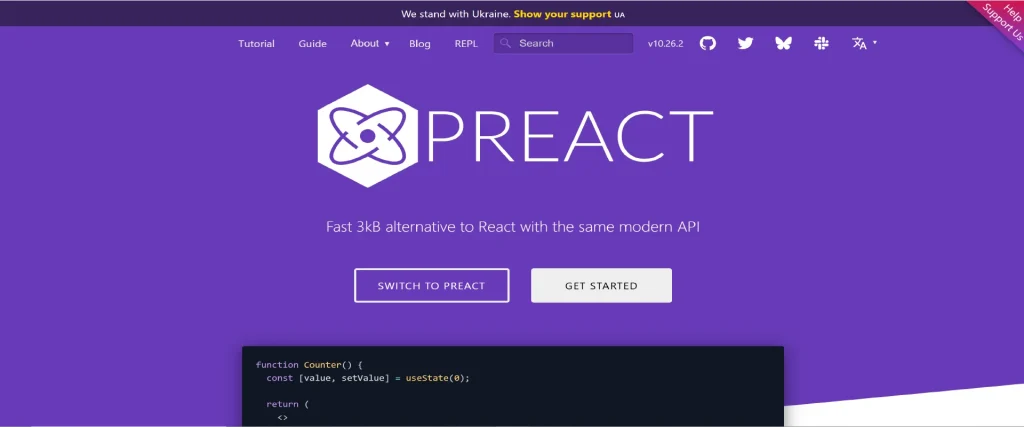
Preact is a lightweight option to React. It offers the same API and features but is much smaller. This makes it great for applications that need high performance. Preact’s component-based architecture and virtual DOM guarantee quick rendering and economical memory use.
It is fully compatible with React components, allowing developers to easily switch to Preact for production without compromising speed.
| Pros | Cons |
|---|---|
| Just 3 KB in size, ensuring fast load times. | Lacks some advanced React functionalities. |
| Easy for React developers to transition. | Missing some validation tools. |
| Low memory usage and fast rendering. | Suitable only for smaller, less complex applications. |
10. Qwik
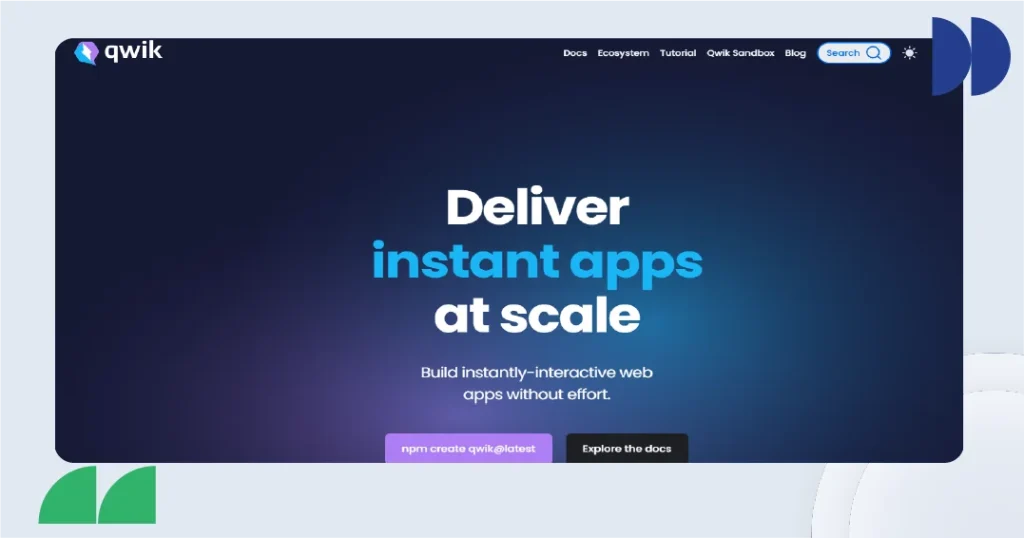
Qwik, made by Misko Hevery, who also created Angular, has a new “resumable” design. This design aims to fix slow page load times. Qwik is still new, but its fast loading speed has caught attention. This is especially true for slower networks and devices.
The primary features of Qwik are below:
- Only the code required for immediate rendering is loaded by the resumable architecture.
- When developers require more code, they load it asynchronously using lazy loading.
- Designed to ensure quick load times across all platforms.
| Pros | Cons |
|---|---|
| Perfect for applications that require high performance. | As still emerging, community support and third-party libraries are few. |
| Made to effectively manage large-scale projects. | A steep learning curve could mean that new architecture. |
| Faster page loads by executing less code. |
In short, Qwik is a framework to watch. It is great for developers who want to improve performance for large, fast-loading web applications.
Frequently Asked Questions (FAQs)
Why Is React.js So Popular Among Developers In 2025?
React.js is popular because it uses a component-based design. It has a virtual DOM and works well with modern tools. This ensures high performance, scalability, and easy development.
What Makes A JavaScript Framework Developer-Friendly In 2025?
A JavaScript framework that is friendly for developers has clear documentation. It has a strong community and easy debugging. It also allows for component reusability and efficient state management. This makes development faster and easier to understand.
Which JavaScript Framework Is Best For Building Scalable Web Apps In 2025?
React.js and Angular are great options for scalability. They provide strong state management, fast rendering, and many tools for large, complex applications.
Conclusion
While React, Angular, and Vue.js continue to dominate, newer frameworks like SolidJS, Qwik, and Astro offer fresh perspectives and performance advantages. Here is a quick overview of all the frameworks that we discussed in this blog:

Each framework has its strengths, making it essential to evaluate them based on your specific use case and frontend development preferences. You can determine the best frontend JavaScript framework based on your project’s requirements, scalability needs, and development preferences.
However, understanding these tools helps you make informed development decisions. It is because your choice of frontend framework can define the success of your application. As frontend technologies evolve, staying updated with the latest tools helps ensure better performance, maintainability, and developer experience.
Want to make the right call for your next build or rebuild? Let’s figure it out together, based on your goals, not just feature lists.








Share your thoughts about this blog!